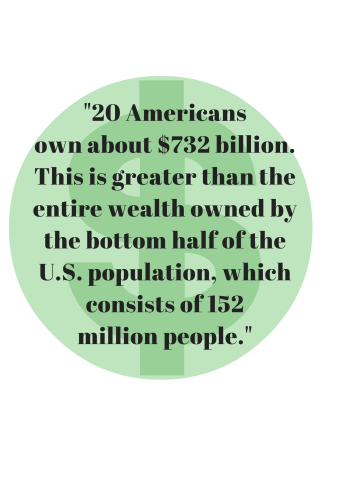The average American wants to live out that ‘American dream’ that is embedded into their brains from a young age.
The goal is to get ahead in life and make more money to support ourselves and loved ones.
Except now, for the average American, there is something major that is standing in the way of reaching that goal.
Two words: wage stagnation.
According to a report by Chuck Collins and Josh Hoxie of Institute for Policy Studies, America’s 20 richest people own more wealth than the bottom half of the population of the United States combined.
This is an issue that affects the majority of the citizens in the U.S. because income for average Americans have stagnated since the late 1970s, while income for the top one percent have climbed steadily.

The latest Forbes 400 rankings state that together, these 20 Americans own about $732 billion. That number is greater than the entire wealth owned by the bottom half of the U.S. population, which consists of 152 million people.
Just let that sink in.
How is it that the American economy system let 20 people have more money than the entire half of the population?
Professor David Murata, an Engagement for the Common Good fellow at the college, discusses and in- forms his students of the income inequality issue in his ECG 300 course.
Murata revealed in an email that the key contributing factors to the gap is due to a combination of many things.
“There are several key factors that cause the major gap of income inequality in the U.S.A.,” Murata said. “Most of the economists would list five or six causes for this, such as globalization, weakened unions and low income tax rate for the top 10 percent of Income Earners.”
“I think it is a combination of several intertwined causes,” Murata said.
According to a pewresearch.org study by Emmanuel Saez, U.S. income inequality has been rising steadily since the 1970s and has now reached levels that have not been met since 1928.
The top one percent of families, the rich, are making way more and paying less in taxes compared to the bot- tom 90 percent, which consists of middle to low class American citizens.
One would think that these numbers would be reversed. Shouldn’t the top one percent be paying more in taxes since their income is steadily increasing and they can actually afford it?
Unfortunately that is not the case.
The rich continue to become wealthier while the poor are only getting poorer.
“In 1965, CEOs earned an average of $832,000 annu- ally compared to $40,200 for workers. According to Fortune.com, in 2014, CEO pay had risen to an average of $16,316,000 compared to only $53,200 for workers,” Murata said.
“So, the common workers’ pay stays relatively the same, while the top executives get paid more than 300 times the average worker,” Murata said.
100 years ago, the rich gained their earnings from the income that was accumulated by their families past generations. Today, the large amounts of money sitting in their bank accounts were not handed to them; they have actually worked for it in jobs that now pay incredibly well.
Yes, one may believe that they should receive whatever is owed to them. Still, the question must be asked that are the CEOs of major companies really worth 300 times the average worker or is the CEO just rewarding himself because he has the power to do so? The gap between the rich and everyone else has grown too large; and America agrees.
A Pew Research Center survey stated that 61 percent of Americans believe that the U.S. economic system favors the wealthy. Only 35 percent said it is fair to most people. Of course, the low and middle-income classes were most likely to say that the economic system favors the rich. However, 52 percent of high-income people said that the economic system indeed does favor the wealthy.
“There will always be the rich and the poor distinction within the current system of capitalism,” Murata said. “One works harder, and one is rewarded better than those who do not work as hard as the one. Question here is a matter of degree.”
How high will the degree of inequality reach?
Only time will tell.
“I think ordinary citizens and residents in U.S.A. can spread the word about this income inequality and the causes for that to everyone,” Murata said. “Tell your parents, siblings, friends, coworkers and everyone who is willing to listen that the government policies to reduce the gap between the rich and the poor must be maintained.”


